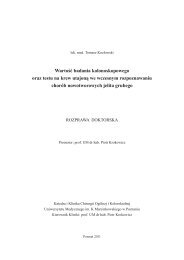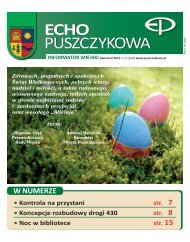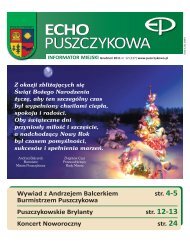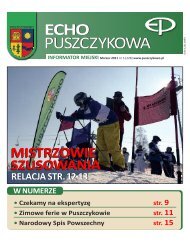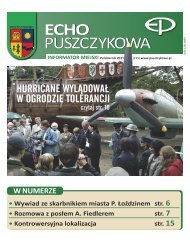MILITARY PHARMACY AND MEDICINE
MILITARY PHARMACY AND MEDICINE
MILITARY PHARMACY AND MEDICINE
You also want an ePaper? Increase the reach of your titles
YUMPU automatically turns print PDFs into web optimized ePapers that Google loves.
© Military Pharmacy and Medicine • 2012 • 4 • 29 – 32Justyna Kołodziejska at al.: Cholesterol oxyethyleneation products as …Determination of ointment viscosity parametersOintment viscosity tests were conducted at32 °C±0.1 °C using a cone/plate digital rheometercoupled with a bath thermostat [12].Determination of the kinetics of the loss of volatileointment componentsPlates with the diameter of d=9cm and totalsurface area of P=63.59 cm2 were covered withuniform ointment layers. Thus prepared sampleswere placed in a dryer-balance at 32±0.1 °C for2.5 and the percentage weight loss readings weretaken every 15 minutes.Determination of the kinetics of the release of lysinatefrom the ointmentThe test was conducted using the technique usedfor transdermal therapeutic systems according toPh.Eur. 6 requirements [13].Figure 1: The relationship between the applied load and the observedincrease in M-Ch-30 Na ointment surface area.Figure 2 compares the extensibilities of all testedointments under the highest load applied duringthe test (227 g).A 5 g ointment sample was placed in a dialysiscontainer with the mass exchange surfaceP=19.625 cm 2 (apparatus accd. to Mutimer etal.). Next, the ointment surface was covered byan appropriately prepared Visking dialysis membrane.Before the test, the dialysis membrane wasexposed to distilled water over 24 h. The entiresystem was closed with the lid and tightened withnuts. Thus prepared dialysis container was placedin a thermostated vessel (32°±0.1 °C), containing0.25 dm 3 of distilled water as a recipient liquid.The solution above the container was put in continuousrotational motion using a stirrer rotatingat 100 rpm. The mass exchange rate was measuredby spectrophotometric analysis of ketoprofenlysinate released from the ointment. Measurementswere made at nine time points over 6hours (samples collected at 40-minute intervals).The amount of the released ketoprofen lysinatewas determined at λ=260 nm using the followingequation: A= 0.4249·c+ 0.0677 (r=0.9991), where:A is absorbance and c is the concentration of thepharmaceutical substance.Results and DiscussionResults of extensometric testsExtensometric tests (measurements of extensibility)allowed to assess products’ capacity toincrease its surface area under the pressure force.Figure 1 presents an example extensibility curve(relationship between the extended ointmentsurface area and the force load applied).http://military.isl-journals.comFigure 2: Comparison of extensibilities of all tested ointmentsunder the highest load applied during the extensometrictest.Extensibility is the measure of product’s capacityto increase its surface area under increasingpressure force. Products of high extensibility areeasily distributed over the administration site.This affects the quality of application. Administrationof ointments on inflamed tissues shouldnot increase the pain sensation. Good extensibilityof the ointment increases the rate of release ofthe active substance at the site of administration.Diffusion of the active substance into the externalcompartment may occur over a large ointmentsurface area that has been spread using alow pressure force.Modification of the absorption base (hydrophilicvaseline) by introduction of novel cholesterol oxyethyleneationproducts increased the extensibilityparameters of all prepared ointments (Fig. 2).In case of ointments prepared using novel ointments,and in case of the highest loads appliedduring the extensometric tests, the surface areasof extended ointments ranged from: 3.61 to 4.52c.u. In case of the ointment with unmodified formula(M-0), the value was 3.15 c.u.29



